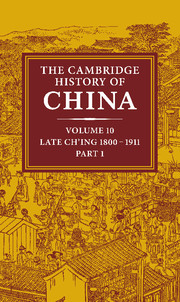Book contents
- Frontmatter
- 1 Introduction: the old order
- 2 Ch'ing Inner Asia c. 1800
- 3 Dynastic decline and the roots of rebellion
- 4 The Canton trade and the Opium War
- 5 The creation of the treaty system
- 6 The Taiping Rebellion
- 7 Sino-Russian relations, 1800–62
- 8 The heyday of the Ch'ing order in Mongolia, Sinkiang and Tibet
- 9 The Ch'ing Restoration
- 10 Self-strengthening: the pursuit of Western technology
- 11 Christian missions and their impact to 1900
- Bibliographical essays
- Bibliography
- Genealogical chart
- Glossary
- Index
- References
3 - Dynastic decline and the roots of rebellion
Published online by Cambridge University Press: 28 March 2008
- Frontmatter
- 1 Introduction: the old order
- 2 Ch'ing Inner Asia c. 1800
- 3 Dynastic decline and the roots of rebellion
- 4 The Canton trade and the Opium War
- 5 The creation of the treaty system
- 6 The Taiping Rebellion
- 7 Sino-Russian relations, 1800–62
- 8 The heyday of the Ch'ing order in Mongolia, Sinkiang and Tibet
- 9 The Ch'ing Restoration
- 10 Self-strengthening: the pursuit of Western technology
- 11 Christian missions and their impact to 1900
- Bibliographical essays
- Bibliography
- Genealogical chart
- Glossary
- Index
- References
Summary
Broad interpretations of late Ch'ing history inevitably revert to the imagery of dynastic decline. Yet a look at some of the political and social detail of the late Ch'ing period will suggest certain limitations of dynastic decline as an integrative concept; and will, perhaps, illuminate some of the elements of long-term social and political change that link the late Ch'ing to the broad trends of China's modern history. Dynastic decline has traditionally implied a loss of moral and administrative vigour among the bureaucracy. However, these phenomena can be understood more easily in the context of the social and political worlds in which bureaucrats had to live, than in the moral categories which adhere to the familiar decline model. Certainly there was rampant corruption throughout the bureaucracy; yet the early nineteenth century also witnessed a surge of concern for institutional reform and national defence among some of China's leading scholars and administrators.
Dynastic decline has been understood as an ebbing of centralized power and its accretion in the hands of regional satraps, a disruption of the balanced tension between state and society. Such a devolution did in some respects occur during the nineteenth century. Nevertheless the Ch'ing institutional format was able, to a surprising degree, to hold China together even in the wake of the century's most destructive civil war, a fact which no doubt ensured that the revolutionary transformations of the twentieth century would take place in a national context, and with the nation's preservation as their primary aim. Thus the degree to which China had achieved national political integration – even in the corrupting patronage systems that pervaded the public life of the scholar elite – must be taken into account as we examine the decline of Ch'ing power since late Ch'ien-lung times.
- Type
- Chapter
- Information
- The Cambridge History of China , pp. 107 - 162Publisher: Cambridge University PressPrint publication year: 1978
References
- 19
- Cited by



